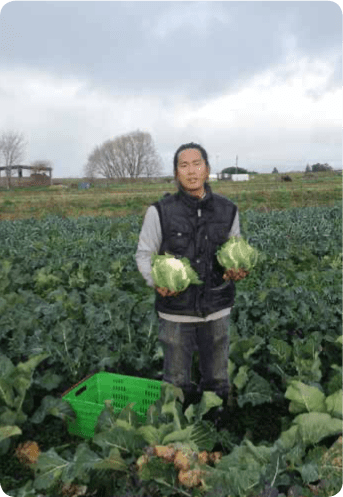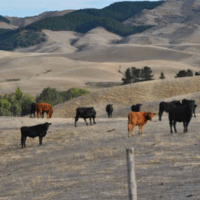My Biodynamic Journey
Harvest Article – Winter 2015
A Chinese immigrant takes naturally to biodynamics
Hongze Yao (known as Yao to friends) was born in a small region in Fujian Province. With a warm and humid maritime subtropical climate, agriculture in Putian has been very popular since the 1950s.
The traditional crop there is rice, followed by vegetables in autumn and winter. Rice and vegetable rotations have been practiced effectively for long periods. Many local growers grew vegetables (brassicas, field tomatoes, celery, etc.) for northern China and Russia in winter before greenhouses were popularly used there.
As a teenager, Hongze got involved with agriculture during school holidays by helping relatives with planting rice seedlings, drying grains, sowing and harvesting peanuts and picking lychee and longan fruits.

After high school, he studied in a joint program between Beijing Forestry University and Michigan State University on Crop and Soil Sciences. He spent half a year in Florida as an intern on a golf course. He worked in the golf industry as an assistant superintendent after obtaining his B.S. degree in 2010. However, the pollution from using chemicals and synthetic fertilizers on the golf course filled him with regret, and he resigned from his work in 2011.
After going back home, he learned from books, the Internet and other farmers. He built three greenhouses with help from friends and families, and grew vegetables with soilless culture for a year before coming to New Zealand.
So how did I get into biodynamics?
Holding a B.S. degree in Crop and Soil Sciences from Michigan State University, I had two years experience in the golf industry and one year in market gardening in China before coming to New Zealand on a Working Holiday visa.
I first learned about biodynamic farming when WWOOFing at Hohepa Poraiti in May and June 2013. After that, I practiced biodynamics as a market gardener at Hohepa Clive, with help from BD experts such as Andy Black, Grant Hughes, Chris Hull and Jenny Lyons. In Dec 2014 I finished the Certificate in Applied Organics and Biodynamics course at Taruna.
How do I understand biodynamics?
As a Chinese person, I found that there were many connections between biodynamics and Chinese culture. This made it relatively easy for me to adapt to biodynamics when I first got into it.
The parallels include:
- The Chinese calendar. Using the moon calendar is a must in biodynamic farming. In China, we normally
use the lunisolar calendar, also called the Yin-Yang calendar, which indicates the moon phase, the time of the solar year and the season of the year. For instance, in this calendar, 15 Aug would always be the mid-autumn day when the moon is largest. However, the dates would be totally different on a solar calendar from year to year. Farmers have been planning their sowing and harvesting on the specific dates for specific crops using the calendar for over 2000 years.
- Yin-Yang theory. When I stirred preparation 500 for the first time, the image that showed up in my mind was the Tai Chi, or Yin-Yang pattern:. Stirring the water produced a pattern that looked similar to the Yin-Yang. My understanding is that the energy of 500 is enhanced at each turning because the end of Yin is the beginning of Yang.
- Traditional Chinese Medicine. BD preps also have their similarities to Traditional Chinese Medicine. In Traditional Chinese Medicine, many things can be used for medicine, from herb to fruit, bone to blood, even insects. The ways of making each medicine are normally identical, but the usage and dose can be very complicated. Additionally, as the BD preps do, their results are obviously good; however, it is not easy to explain why, what and how using modern scientific terms.
Meanwhile, because of my background in science studies, I tried to understand biodynamics through ways that could be explained with science language. For example, I see CPP (cow pat pit) as a mixture of carbon fiber, microorganisms and other elements. Similar to using Bt, after mixing CPP with water, the microorganisms multiply dramatically and act as a protective coat when applied to plants. Therefore, CPP helps to control disease, not by killing the pathogens but by competing with them instead.
How do I practice biodynamics?
With the help of other biodynamic experts, I have managed to practice biodynamic farming easily and efficiently. However, personally speaking, I normally question the knowledge that comes from books or from other people, because things change. Here are a few examples of how I have practiced biodynamics:
- Using the biodynamic calendar. Ideally, I sow seeds or cultivate the land on the dates shown in the calendar. But if the weather is bad before the planned dates, I would compromise to cope with the weather.
- Applying biodynamics with proper knowledge. For instance, lots of compost or plenty of water is not always good. Root crops such as beetroot or kumara yield poor results because they try to grow more leaf instead of storing more nutrients in their roots.
- Weeds are not always my enemies. If they are not competing too much with my crops, I appreciate them, because:
- they create habitats for insects, worms and other beneficial creatures;
- they cover bare soil, protecting against heat and erosion;
- they absorb pressure from farmers and machinery; » once they die, they help to build up the organic matter level in the soil;
- those with deep roots utilise minerals from deep in the soil.
After being a biodynamic market gardener for two years, I witnessed many good results: healthy soil, nice-tasting crops, good resistance to bad weather such as drought or wet, good biodiversity on the farm, a happy mood in daily work and a positive attitude for life.
It’s my first time writing an article like this. I would like to share my experiences with my friends or whoever is interested in agriculture. I prefer not to start with complicated theories of stars and preps, but to let them try biodynamic products and ask for their comments.
I am sure most people would give positive feedback on the produce – and the next question they would probably ask is: “How did you grow them?”



